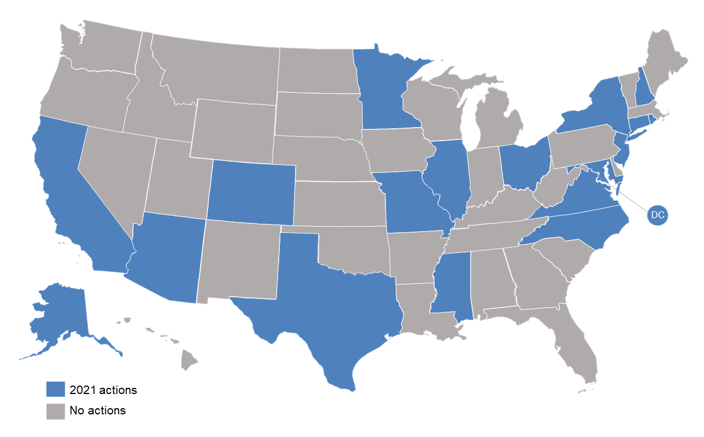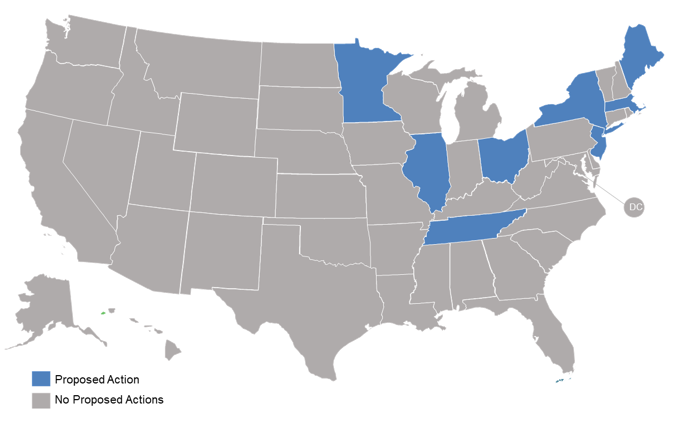By: Vincent Potter, Policy Analyst
Advanced Metering Infrastructure (AMI) is a key facet of grid modernization. AMI goes beyond meters, relays, switches, and other physical components of the grid. Each field device can potentially gather and transmit data about its status and the characteristics of the power that flows through it. Each field device is a potential data point that utilities and customers can leverage to make the best possible decisions. The data gathered can be sensitive; learning the exact load details of a factory can reveal some trade secrets. Likewise, residential load profiles can show occupancy, activity, and sleep schedules that many would not share publicly.
Throughout 2021, 27 separate state or utility actions dealt with electricity data and data access. The 50 States of Grid Modernization 2021 Annual Report contains data about the progress and content of many of the bills and dockets regarding expansions in deployment of advanced infrastructure capable of collecting data and specific plans for utility utilization.
2021 Data Access Policy Actions
Data Acquisition
Advanced metering infrastructure is capable of measuring and transmitting large quantities of data back to a server. Electric meters can measure, in some cases minute-by-minute, changes in load demand and consumption patterns. Taken over long periods, this data makes a load profile that can be analyzed and used for any number of tasks by utility companies and end-users. Through careful analysis, utilities can make extrapolations for future usage trends or closely monitor grid outages in real time. Customers can use this data to find optimal times to run their industrial operations, determine benefits of on-site generation, or to decide on climate control schedules.
Depending on the configuration of the system, advanced metering data can be presented in several ways. Real time information streams in from meters and field devices to servers for immediate or short-term analysis. Utilities can use this data to follow load curves and make tweaks to their dispatched generation. Historical data in 15-minute or 1-hour intervals can show usage trends over time. If real-time data affects day-to-day operations, then interval data is used for longer term planning. Historical interval data, for example, might be used to create a demand response plan to reduce peak load, but real-time data would be needed to deploy it most effectively.
The glut of information from smart meters goes well beyond the historical utility purview of financial information and generation capacity and dispatch. Lawmakers and regulators are increasingly requiring utilities to safeguard customer energy data, and for good reason. By analyzing the load profile of buildings, a viewer can gain much information about what is going on inside. One can determine operational schedules, occupancy hours and trends, when large appliances are run, etc. While the utilities are entrusted with all of this information, they must take measures to aggregate and anonymize data when reporting to third parties. In some states, utilities can only provide customer energy data to third parties with customer consent.
As of February 2022, eight states have bills pending in their legislatures that deal broadly with customer data access. These range from rules about whether utilities can sell their energy data to requiring utilities to articulate their plan for dealing with advanced metering infrastructure data. Most either require customer consent or explicit privacy rules before utilities can disclose non-aggregated data to third parties. Some regulators and lawmakers are also proposing rules that would provide customers with no-cost access to their data, requiring utilities to add to existing or create new web portals.
Pending Data Access Legislation (February 2022)
Customer Data Uses
Customers of all rate classes can use their energy data to make more informed energy consumption decisions. Residential customers can sometimes have less control over their electrical demands than commercial and industrial customers but interval data can still prove useful, especially over time. If a residential customer has the same loads over time, but increasing energy usage, the data can tell them when their consumption is changing to help identify problems with equipment inside their home.
Many large commercial and industrial operations have dedicated energy management strategies and employ devices that can monitor the energy needs of electrical panels or pieces of equipment. Electric data from advanced meters can supplement this pinpoint data to show the “big picture” of energy use at a facility. Commercial and industrial customers often have equipment driven by motors with large startup energy demands, but relatively lower continuous energy needs. Granular energy data can tell these customers what their energy use pattern is so that managers can determine the optimal schedule for equipment use to minimize electric demand (and demand charges).
All customers who pay based on their peak electric demand can benefit from real-time or interval electricity data. Bills and utility records from the analog era can only tell a customer what their peak consumption was and not when it occurred. Smart meter data can show the customer how their energy use changes over time so that they can match their energy peak with their system operations and decide if their peak energy use can be reasonably reduced. Peak reduction strategies include changing operation schedules, retrofitting equipment and facilities, or offsetting peaks directly with on-site generation or energy storage. Deployment of energy storage or generation to reduce peaks depends on accurate real-time energy data for the best results.
Customers can also leverage the data from advanced metering to compare utility rate options. Many electric tariffs do not charge different prices for consumption at different hours of the day, meaning that customers have little economic incentive to change their consumption behaviors. With time-varying rates, sometimes called “Time of Use” or “Time of Day” pricing, utilities charge different prices throughout the day to partially reflect the expense of generating excess energy during periods of high demand. Using granular energy data, customers can compare their energy use with their utility’s rate offerings to either determine the best tariff to match their consumption pattern, or to tell what activities they may need to alter to best deal with a new electric rate.
Utility Data Uses
Utilities have employed demand response programs in varying forms for decades. These programs allow the utilities to isolate and de-energize certain equipment in times of high energy demand. Typical targets for demand response programs include air conditioners and large equipment on intermittent schedules.
An outage management system (OMS) collects reports of power outages and can predict failed equipment and fault location related to system reports of outages. Customer-facing data for system outages come from these systems, they also record outages and less serious system faults for regulatory reporting. OMS manage unexpected fault data including detection, location, repair and isolation. An OMS is a coordinator for tasks, planning outages, recordkeeping, and processes associated with distribution system outages. OMS can be a communication system for utility stakeholders, internal and external, and provide the backbone of outage notifications for app or web interfaces.
Advanced OMS can use precise location data to display faults and system issues in real time. OMS can reduce the need for searching for faulty parts of a distribution system and thereby lessen the time for personnel to start repairs to restore operations. Combined with remotely operated switches, faulty sections of the network can be isolated or bypassed to maintain service to as many customers as possible. The utility can use the OMS to make predictions for system behavior during faults and use that data to inform their planning efforts.
Utilities have to factor in a lot of information to plan for system upgrades and additions. Using granular data as part of energy modeling, utilities can form a more complete picture of their customer demands and plan accordingly. Generation and transmission capacity can be compared to usage trends and data from their customers, which can provide more relevant information than generalizations or industry standard data. In the context of transmission build-out, the utilities can use real data from their service area to see where their feeders and infrastructure may soon be insufficient and allocate funds accordingly.
Overall
Both utilities and customers make decisions with the best data available at that moment. Advanced metering infrastructure can provide utilities with more precise and more reliable data for planning and system operations. Customers can take advantage of this data as well to make the best decisions on how and when to consume electricity, choose the best rate option to fit their needs, and identify potential equipment problems that may not be immediately obvious. Because energy data can reveal so much about operations, schedules, and even personal habits, there are many regulations on how this data is stored and presented. Lawmakers and regulators are directing utilities to become custodians of customer data; many utilities are required to protect customers’ data and make it available to customers and their designees through secure means.
* * *
Keep up with legislative and regulatory changes related to data access with the 50 States of Grid Modernization report or DSIRE Insight’s Single-Tech Grid Modernization Subscription.


